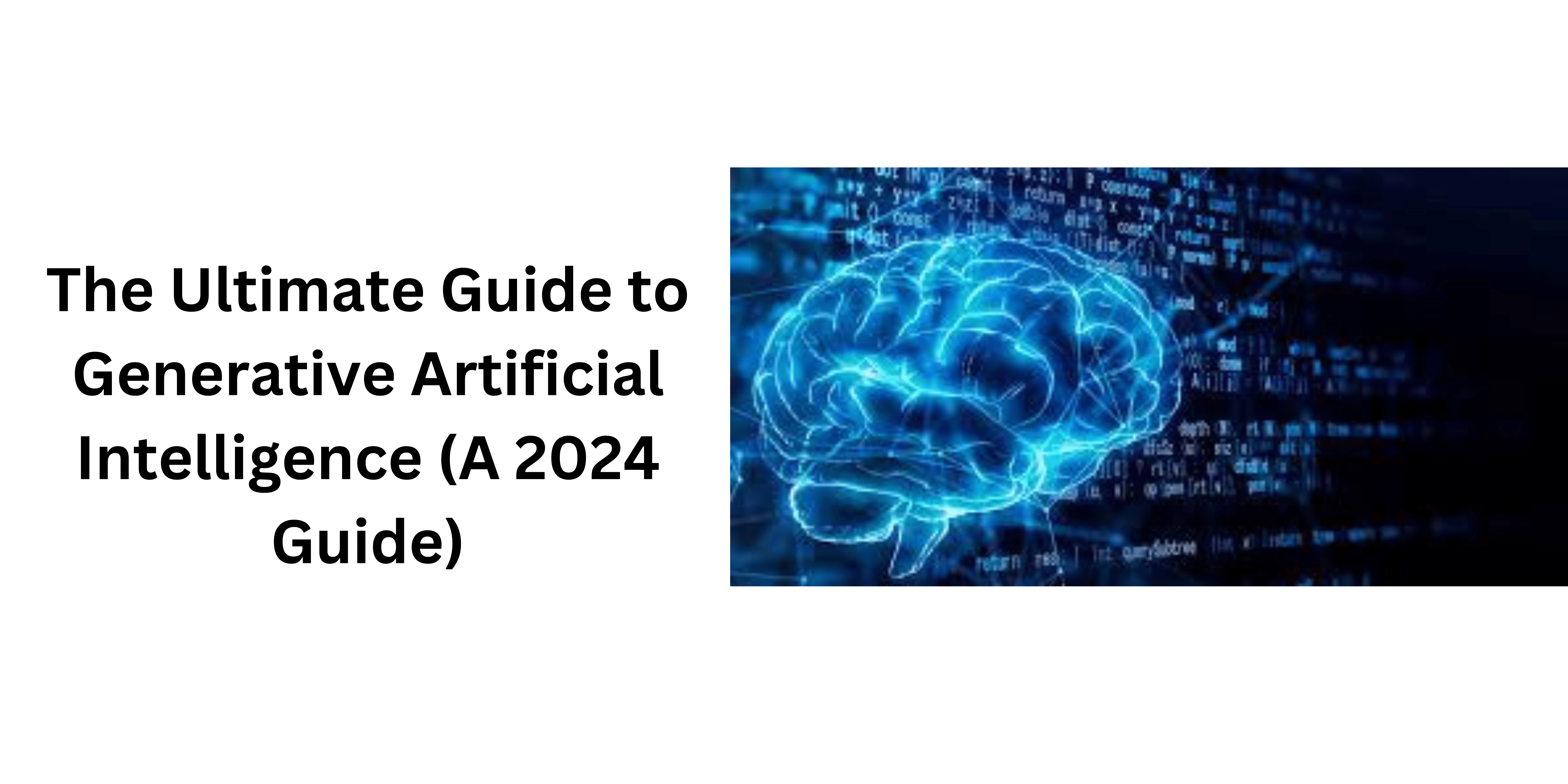In the ever-changing world of artificial intelligence, a revolutionary area that has received much interest has been Generative AI. As we approach 2024, the capabilities of Generative AI technology continue to transform industries, changing how we think about innovation, problem-solving, and data generation. This guide exposes the multiple aspects of Generative AI, offering a complete overview of its underlying principles, applications, and transformative capabilities.
Generative AI, aided by the latest algorithmic machine learning, allows systems to generate content that includes text, images, or even complete scenarios. Its applications cover various industries, including design and art finance, healthcare, and more, bringing forth an entirely new world of possibilities. Understanding the changes in the most advanced models and ethical issues becomes crucial when we traverse this complex environment.
As we move through this transformational adventure, innovators and businesses look to tap into the power to use Generative AI to remain competitive. If you want to investigate and use these tools, working with a reliable Generative AI development company is crucial. The guide below will explore the intricate details involved in Generative AI and clarify the significance and role of a Generative AI development company when it comes to navigating this cutting-edge landscape. Join us on a journey into the complex landscape of Generative AI, revealing its potential and opportunities in 2024 and beyond.
Evolution of Generative AI Technologies
The development of Generative AI technology is an impressive progress from the beginning to the advanced landscape we will see in 2024. Initially, Generative AI models faced limitations in producing realistic and consistent content. However, the field quickly developed as researchers uncovered new methods of training and architectures and ushered in an era of innovation and creativity.
The introduction of Variational Autoencoders (VAEs) and Generative Adversarial Networks (GANs) in the mid-2010s greatly accelerated the development of Generative AI. VAEs provided probabilistic frameworks for latent space representation, allowing more controlled and structured content generation. GANs, on the contrary side, revolutionized the field by introducing an interplay between two generators and a discriminator, encouraging the production of extremely real-looking outputs.
In the following years, Transformer models, as demonstrated by OpenAI’s GPT series, evolved the natural processing of language and generation. These models proved the efficacy of self-supervised, large-scale learning and demonstrated the capability to create consistent and relevant texts.
As Generative AI progressed, researchers began to explore multimodality, which allowed models to create content in diverse modalities, including images, text, or even music. This convergence of modalities widened the range of applications available, from creating realistic images to creating music and various original content.
By 2024, this development will continue with ever-more sophisticated structures, more effective training methods, and a concentration on ethical issues. The evolution of Generative AI is not just about technological advances but also an ongoing search to expand the boundaries of what AI can do and create across various fields.
Key Principles and Concepts in Generative AI
Understanding the fundamental concepts and theories in Generative AI is vital to understanding the complexities of this revolutionary field. The fundamental concept behind Generative AI revolves around creating content on its own using advanced machine learning algorithms. The foundational principles of Generative AI are the basis of its capabilities and applications.
Probabilistic Modeling
Generative AI uses probabilistic models to represent the uncertainties inherent in the data it processes. Methods like Variational Autoencoders (VAEs) employ probabilistic frameworks to depict latent spaces that allow for structured and controlled content generation.
Adversarial Learning
The idea of adversarial learning, prominently discussed as a key feature in Generative Adversarial Networks (GANs), is a dynamic interaction between entities: a discriminator and a generator. This process of adversarial learning helps create realistic and high-quality content by continuously developing the model through contests.
Transfer Learning
Many Generative AI models rely on transfer learning, where previously trained models based on massive datasets are tuned to specific tasks. This method allows for the effective utilization of information acquired from various fields and enables the creation of more contextually-aware and flexible model-based generative models.
Self-Supervised Learning
One of the most important aspects of recent advances in self-supervised learning, particularly in Transformer models such as GPT, is the process of training models using large volumes of data that do not have labels. This allows the model to understand contextual relationships and to develop semantic understanding, which allows it to create pertinent and coherent content.
Entrepreneurs and innovators frequently turn to Generative AI development services for actual applications to maximize their potential. They offer the knowledge of specialists who know the specifics of creating and optimizing Generative AI models for specific applications. In the case of developing custom generative solutions or incorporating existing workflows with models, Generative AI development services play an integral part in translating theory into effective real-world applications.
Applications and Industries Transformed by Generative AI
Generative AI has created an era of transformation across many industries, changing how tasks are tackled, unleashing creativity, and creating data. The applications go far beyond traditional boundaries, affecting diverse sectors profoundly.
Art and Design
Generative AI has been an engine for invention and innovation in creativity. It has redefined possibilities for creative expression, from generating original art pieces to aiding designers in generating ideas. Deep neural networks are instrumental in creating amazing and conceptually stunning designs.
Healthcare
Generative AI contributes to medical imaging, drug discovery, and personalized medicine in healthcare. Generative models study medical images to diagnose and simulate drug interactions and assist in generating synthetic data to train health algorithms, ensuring the availability of diverse and robust datasets.
Finance
Financial institutions use Generative AI for risk assessment in fraud detection, risk assessment, and algorithmic trading. Generative AI’s ability to create artificial financial data helps stress-test models and improve predictive analytics to help identify investing strategies and market trends.
Marketing and Advertising
Generative AI is changing the marketing landscape by automating content creation, creating specific advertisements, and creating virtual influencers. This technology lets marketers adapt content to specific audiences, which increases the quality of engagement and visibility of brands.
Gaming
The gaming industry benefits from Generative AI for the procedural creation of content-designing characters and immersive virtual worlds. The dynamic and adaptive content for games enhances gamers’ experience, offering customized and dynamic gameplay scenarios.
Language Translation and Natural Language Processing
In the language field, generative AI models such as GPT help with the accurate translation of languages, content summarization, and Chatbot design and development. These tools significantly enhance accessibility and communication globally.
In the years ahead, as Generative AI continues to evolve in its application to industries, its impact will likely grow, encouraging improvement and productivity across various fields. The capability to create real-time and relevant content has established Generative AI as a revolutionary force with huge potential to influence the future of diverse industries.
In 2024, the landscape of Generative AI is defined by an impressive variety of cutting-edge models that each push the boundaries of artificial intelligence’s capabilities. These models of the future have shown incredible capabilities to create real-time and contextually relevant content across different types of media.
GPT-4 (Generative Pre-trained Transformer)
Based on the success of its previous versions, GPT-4 stands at the top of the line in the natural processing of languages. Created by OpenAI, this model based on Transformer has improved language understanding, enhanced context retention, and the capability to create precise and complex text on various topics. Businesses looking to benefit from this powerful tool frequently use AI development services to ensure seamless integration and customization.
DALL-E 2
Following in the footsteps of the first DALL-E model, the model developed by OpenAI concentrates on creating stunning and diverse images from textual descriptions. DALL-E 2 showcases advancements in image synthesis that allow the creation of imaginative and clear images. AI Development services are essential in developing DALL-E 2 for applications ranging from design creation to content automation.
CLIP (Contrastive Language-Image Pre-training)
The model was developed through OpenAI; CLIP is a revolutionary model that can holistically comprehend texts and images. Its cross-modal capabilities allow tasks like the classification of images using textual prompts, showing the versatility of vision language understanding. Integration of CLIP into workflows typically requires specialized AI development services to maximize the potential of CLIP for specific applications.
StyleGAN 3
The evolution of image creation is demonstrated in StyleGAN 3. The model is renowned for its capacity to create photographs with high-resolution and photorealistic quality and is being used in design, art, and virtual worlds. Companies that want to incorporate StyleGAN 3 into their creative processes can benefit from AI development services to adapt the model to meet their needs.
The latest Generative AI models in 2024 will show technical proficiency and demonstrate the significance of specialist AI development services for efficiently deploying these models in practical applications. When businesses begin to explore the potential of these systems, collaborating with AI development services is essential in navigating the complexity of integration, customizing, and optimization to suit specific usage situations.
Ethical Considerations in Generative AI Development
Ethics aspects regarding Generative AI development have become more important as technology evolves and its applications grow in different fields. Addressing these issues is crucial in ensuring the ethical and responsible implementation of Generative AI models.
Bias and Fairness
Generative AI models may inadvertently perpetuate biases in the data used to train and result in biased outputs. Ensuring fairness in AI systems requires thorough investigation and elimination of biases to stop unfair results. Ethics-based development practices aim for fair and inclusive designs while avoiding the perpetuation of prejudices in society.
Privacy Concerns
Generative AI, especially for applications such as deepfake generation, poses significant privacy issues. The unauthorized use of personal information to generate artificial content could cause serious harm. The ethical development process requires rigorous security measures for privacy with consent mechanisms and clear guidelines for the use that is responsible for generated content.
Manipulation and Misuse
Generative AI’s ability to create high-quality content comes with the possibility of malicious players using it to deceive or mislead information. The ethical considerations of Generative AI require developers to take precautions against abuse by Generative AI, including creating fakes for criminal motives.
Transparency and Explainability
The complexity inherent to Generative Artificial Intelligence models like deep neural networks presents difficulties when understanding decision-making. The ethical development process emphasizes transparency and clarity, allowing users to understand how models come up with their conclusions and building confidence in their use.
Security Risks
Generational AI models are prone to attack from adversaries, where intentional manipulations could compromise their capabilities. Ethics-based development practices include implementing strong security measures to protect against attacks that could be able to compromise the model and ensure the model’s reliability in real-world situations.
Long-Term Impacts
Ethics considerations are also relevant to the long-term social impacts of Generative AI. Developers need to anticipate the potential impacts, such as job loss, changes in economics, and the impact on culture, and find solutions to mitigate negative effects and improve societal results.
To navigate the ethical dimensions of Generative AI development, the industry players, policymakers, and developers must work together to develop complete norms and regulations. An ethical commitment is vital to reap the potential benefits of Generative AI while decreasing the risk of its use and ensuring its safe and fair integration into society.
Practical Implementation and Integration Strategies
Integrating and implementing the use of Generative AI into diverse applications requires a strategy based on particular use cases and goals of the organization. To harness the potential for transformation offered by Generative AI, collaboration with an expert AI development company is crucial in navigating the implementation challenges.
Customization for Specific Use Cases
The success of implementation is based on an understanding of the particular use cases and goals. An AI development company is essential in tailoring Generative AI models to meet the particular demands of a particular sector or industry and ensuring that the technology is in sync with the organizational requirements.
Data Preparation and Augmentation
The quality and variety of the training data significantly impact the efficiency of the Generative AI model. AI development services can excel in data preparation and enhancement and refine data sets to improve model resilience and generalization. This involves cleaning, labeling, and enriching the data to increase the accuracy of the model and its reliability.
Scalability and Performance Optimization
Effective integration requires addressing issues related to scaling and maximizing your performance in Generative AI models. AI development firms employ methods like model parallelizing, parallel processing, and distributed training to increase effectiveness, ensuring that the models can be scaled to meet the requirements in real-world situations.
User Interface and Experience Design
Implementing Generative AI often involves incorporating the technology into user interfaces or interactive systems. An AI development company proficient in user experience (UX) design will ensure a seamless integration that increases user satisfaction and interaction by making the technology more user-friendly and accessible.
Continuous Monitoring and Maintenance
Monitoring after implementation and ongoing maintenance are essential for the effectiveness of Generative AI models. AI development companies use sophisticated monitoring tools that monitor the model’s performance, identify irregularities, and make needed updates, ensuring the durability and security of their integrated solutions.
Collaboration with an AI development firm brings knowledge and expertise on the job, enabling companies to overcome the difficulties associated with Generative AI applications. Through customizing models, maximizing performance, and providing continuous assistance, these firms help in the success of integrating Generative AI into various applications and unlocking its full potential for efficiency and innovation.
Advancements and Trends Shaping the Future of Generative AI
What lies ahead for Generative AI is set to be shaped by an array of new developments expected to accelerate this revolutionary technology to new frontiers. Looking ahead to the future, several key developments are gaining momentum as the main drivers for advancement and innovation.
Hybrid Models
The future of Generative AI systems will likely see the combination of hybrid models combining different technologies’ strengths. This could result in models that can seamlessly generate various types of content like images, text, and even immersive experiences.
Unsupervised and Self-Supervised Learning
The trend toward self-supervised and unsupervised learning continues to grow. This trend reduces the dependence on labeled data and allows models to draw lessons from massive amounts of unannotated data, which increases their capacity to adapt across a vast spectrum of tasks.
Explainable AI (XAI)
When Generative AI models get more complex, the need for explanations increases. The future trends will likely concentrate on making models easily interpretable and providing insight into their decision-making process. AI will be essential, particularly in areas with high stakes, like finance and healthcare.
Ethical AI Development
With a growing awareness of the ethical impacts of AI, There is an increasing emphasis on ethical and responsible AI development. The future will likely see the inclusion of ethical considerations into the development and implementation of Generative AI, addressing issues that concern bias fairness, transparency, and bias.
Edge Computing for Generative AI
The use of computing on the edge in Generative AI is expected to increase, allowing on-device processing and reducing the dependence on central cloud servers. This improves privacy, lowers latency, and makes Generative AI more accessible in diverse applications, such as IoT phones and other mobile devices.
Climate-Conscious AI
The future developments of Generative AI will likely incorporate an emphasis on sustainability for the environment. The efforts to create models that are energy efficient and training techniques are expected to be prominent, coordinating AI advancement with international initiatives that aim to reduce carbon footprints.
As these developments and trends develop, the future of Generative AI holds promise for more flexibility, ethical accountability, and broad applicability across different industries. Continuous advancement and an active approach to solving issues will be essential to realizing the possibilities in Generative AI over the coming years.
Challenges and Limitations in Generative AI
Generative AI, although transformative, has its share of limitations and challenges that make it difficult to create and deploy these advanced models. Understanding and addressing these challenges is crucial to unlocking all the potential in Generative AI through innovative AI development tools.
Data Quality and Bias
Generative AI heavily depends on the training data, and problems with the data quality and the biases in the data sets can greatly affect the performance of models. Incorrect data in training could result in biased outputs, which can perpetuate societal inequalities. Finding solutions that guarantee that the data are representative and diverse is the most important aspect of solving this problem.
Interpretability and Explainability
The inherent complexity of various Generative AI models poses challenges in understanding their decision-making. Understanding why and how models produce a particular output is vital, especially in high-risk areas such as finance or healthcare. Ai developing solutions that enhance the interpretability of models and explanations is essential for creating confidence and, of course, accountability.
Computational Resources
Training and deploying complex Generative AI models demand substantial computational resources. The high-resource model presents difficulties, especially for smaller businesses with a small infrastructure. Optimizing models and designing efficient AI development strategies to reduce the demands on computation are essential aspects to consider.
Security Concerns
Generative AI models are vulnerable to attack from adversaries, where intentional manipulation of input data could cause inaccurate outputs. Ensuring security measures are robust and creating solutions to protect against attacks from adversaries are crucial to ensuring the security of Generative AI models.
Ethical Considerations
The ethical application for Generative AI is a pressing issue, particularly regarding applications such as deepfakes. The equilibrium with innovation while maintaining ethical accountability requires constant scrutiny and creating complete AI design solutions that integrate ethical concerns in the design and implementation procedures.
To address these issues requires researchers, developers, and other organizations in a team effort to develop new AI development strategies that increase the quality, fairness, and moral standing of Generative AI in the constantly changing AI landscape.
Best Practices for Developing and Deploying Generative AI Solutions
Implementing and developing Generative AI solutions involves navigating the complexities of ensuring robustness, ethical considerations, and seamless integration. Implementing best practices is crucial to maximize the value of Generative AI while minimizing any dangers.
Understand the Problem Domain
Learn about the issue before launching into Generative AI development. It is important to clearly define the objectives, constraints, and ethical issues to determine the development process.
Quality Data and Diverse Datasets
Ensure high-quality, diverse datasets for training Generative AI models. Correct biases in the data to stop the model from creating new inequalities. Continuously update and expand the datasets to enhance the generalization of models.
Ethical Design Principles
Integrate ethical concerns in your design processes. Integrate transparency and fairness in addition to accountability systems. Look for models that can be explained and understood that encourage trust and responsible use.
Iterative Development and Testing
Use an iterative development method with constant testing and verification. Continuously evaluate the model’s performance as well as identify areas of weakness. Improve the model with successive iterations to increase its capabilities.
Consider Security Measures
Install robust security measures to protect Generative AI models from adversarial attacks and unauthorized access. Securely store data, employ secure communications protocols and periodically examine security protocols to guarantee system security.
User-Friendly Interfaces
Create user-friendly interfaces that ease the interaction of Generative AI applications. Make sure that the user experience is easy to use by providing clear directions and interaction choices and altering the generated content.
Continuous Monitoring and Maintenance
Set up a system that allows constant monitoring and maintenance following deployment. Update models regularly to adjust to the changing distribution of data, address new issues, and implement improvements to ensure an optimal level of performance.
Educate and Train End Users
Offer comprehensive education and training for users who want to know the capabilities, limitations, and ethical concerns related to Generative AI solutions. Promote responsible and informed use of the technology to prevent misuse or misinterpretation.
Scalability and Resource Optimization
Develop solutions that can be scaled and efficient in terms of resources. Be aware of the computational demands, particularly for training. Also, design models to run on various platforms and devices, including edge devices.
Conformity to Regulations
Ensure you comply with the relevant laws and standards that govern data security, privacy, and ethical AI practices. Keep up-to-date with the legal requirements and follow specific industry guidelines.
By following these best methods, companies and developers can navigate the complicated landscape of Generative AI development and deployment by encouraging responsible development and ensuring these powerful technologies benefit the various domains and industries.
The Impact of Generative AI on Society and the Economy
Generative AI is emerging to be a powerful force with significant implications for the economy and society. The impact of Generative AI is diverse and profound on how we think, create, communicate, and manage business. The impacts generated by Generative AI development are evident across various areas.
Creative Resurgence
Generative AI has led to the creative boom by assisting designers, artists, and creators in creating new content. From music and art to design and literature, the ability of AI to generate content autonomously has redefined the limits of human imagination, resulting in different forms of expression and innovation.
Economic Productivity and Efficiency
In the business world, Generative AI contributes to improved efficiency and productivity. Industries rely on the automated creation of content data generation, data generation, and decision-support systems that help streamline processes, reduce manual burdens, and improve overall efficiency.
Job Landscape Transformation
While Generative AI is a major contributor to economic activity growth, it triggers an evolution in the employment market. Routine and repetitive tasks could be automated, requiring changes in the skill set required by the job market. The need for skilled workers for Generative AI development creates new opportunities and emphasizes the importance of upgrading skills and flexibility.
Healthcare Advancements
Generative AI is making major advances in healthcare, ranging from medical imaging analysis to the discovery of drugs. This technology speeds up research and improves diagnostic abilities, eventually enhancing patients’ quality of life and aiding in medical science advancement.
Ethical and Social Considerations
The consequences of Generative AI extend to ethical and social concerns. Deepfake technology raises concerns over privacy and misinformation, requiring society to consider the ethical development and implementation of Generative AI. Finding an equilibrium between the use of technology and ethics is a must.
The transformational effects of Generative AI on society and the economy highlight the necessity to adopt accountable Generative AI development practices. As Generative AI grows, it offers challenges and opportunities that require careful navigation to ensure that it has a fair and sustainable impact on our societies and economic systems.
Resources and Tools for Exploring Generative AI
The exploration of Generative AI involves delving into the vast tools and resources that support this revolutionary technology’s learning, development, and use. If you’re a researcher, developer, or enthusiast, a range of resources are available to help guide and facilitate your exploration into the world of Generative AI.
Online Courses and Tutorials
Platforms such as Coursera, Udacity, and edX provide comprehensive classes in Generative AI, covering foundational concepts, models, and practical applications.
Research Papers and Publications
The most prestigious conferences and journals in machine training and artificial intelligence, including arXiv, give researchers access to papers that examine the most recent advances regarding Generative AI.
Open Source Frameworks
Frameworks such as TensorFlow and PyTorch are vital for implementing Generative AI models. Their comprehensive documentation, tutorials, and assistance from the community make them essential for both experienced and novice developers.
Model Repositories
Platforms such as Hugging Face and TensorFlow Hub offer model repositories and an array of already-trained Generative Artificial Intelligence models that can be integrated into various applications.
Online Communities
Participating in online communities, like communities on Reddit (e.g., R/Machine learning) and platforms such as Stack Overflow, allows you to ask for advice, exchange ideas, and work with colleagues in the Generative AI area.
Generative AI Development Platforms
Cloud-based platforms such as Google Colab, Microsoft Azure, and AWS offer the opportunity to develop and test Generative AI algorithms without paying for large local resources.
Books and Publications
The most authoritative books, such as “Generative Deep Learning” by David Foster and “Hands-On Generative Adversarial Networks with Keras” by Rafal Zapala, offer deep insights and practical guidelines to understand and implement Generative AI.
Online Challenges and Competitions
Platforms such as Kaggle offer competitions related to Generative AI, real-world problems to solve, and opportunities to learn from and work with the international scientific community.
Utilizing these tools and resources lets people explore the world of learning, sharing, and contributing to the rapidly growing subject of Generative AI. The abundance of materials available will provide a stimulating experience in this ever-changing field, be it industrial applications, academic research, or personal projects.
The Key Takeaway
Ultimately, the trip across the vast landscape of Generative AI is a tangle of challenges, innovation, and a profound impact. We are amid the potential for transformation of Generative AI, which is evident across many sectors, including creative ventures and healthcare, to economic productivity and social dynamics. The development of models such as DALL-E, GPT, and StyleGAN is not just about technological advancements but also the constant effort to test the limits of what AI can accomplish.
As we advance, the ethical aspect becomes a major factor in guiding the responsible design and implementation of Generative AI. A balance between technology and ethical responsibility demands collaboration, transparency, and a commitment to address privacy issues and biases.
In this ever-changing world, companies and individuals seeking to make the most of the power of Generative AI can benefit from the skills provided by an AI development Agency. These agencies have specialized expertise, experience, and a holistic approach to dealing with the challenges of creating the right Generative AI solutions. By combining ethical methods of development and a shared dedication to ethical AI, we can create a future in which Generative AI contributes positively to society, encourages innovation, and enhances human interaction.











